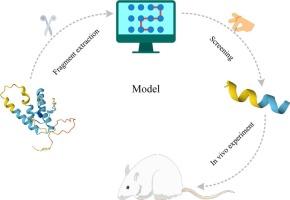The discovery of wheat-derived anticaries peptides by a ML-based computational strategy
IF 3
3区 医学
Q2 BIOCHEMISTRY & MOLECULAR BIOLOGY
引用次数: 0
Abstract
This study proposes a machine learning-based peptide screening strategy for identifying wheat-derived peptides with anti-caries potential. By integrating multiple feature descriptors and algorithms (Random Forest, XGBoost), we constructed a Screening Funnel Model and identified a wheat-derived peptide AP-2 (FPVTWRWWKWW) as the prioritized candidate. Experimental validation demonstrated that AP-2 exhibits potent antibacterial activity against Streptococcus mutans (MIC = 4 μM), achieving rapid bactericidal effects through bacterial membrane disruption, and significantly inhibits biofilm formation at 1/2 × MIC concentration. AP-2 exhibited an extremely low hemolysis rate and demonstrated favorable stability in saliva within 1 h. In vivo, studies confirmed that AP-2 effectively prevents early caries formation in rats at low concentrations without inducing organ toxicity or oral microbiota dysbiosis. These results demonstrate the utility of machine learning in discovering wheat-derived anti-caries peptides and indicate that AP-2 represents a safe and effective candidate for clinical translation.

基于ml计算策略的小麦衍生抗肿瘤肽的发现
本研究提出了一种基于机器学习的肽筛选策略,用于识别具有抗龋潜力的小麦衍生肽。通过整合多个特征描述符和算法(Random Forest, XGBoost),我们构建了筛选漏斗模型,并确定了小麦衍生肽AP-2 (FPVTWRWWKWW)作为优先候选。实验验证表明,AP-2对变形链球菌(MIC = 4 μM)具有较强的抑菌活性,通过破坏细菌膜实现快速杀菌效果,并在1/2 × MIC浓度下显著抑制生物膜的形成。AP-2溶血率极低,在唾液中1小时内表现出良好的稳定性。体内研究证实,低浓度AP-2可有效预防大鼠早期龋齿形成,且不会引起器官毒性或口腔微生物群失调。这些结果证明了机器学习在发现小麦来源的抗龋肽方面的效用,并表明AP-2代表了一种安全有效的临床转化候选者。
本文章由计算机程序翻译,如有差异,请以英文原文为准。
求助全文
约1分钟内获得全文
求助全文
来源期刊

Bioorganic & Medicinal Chemistry
医学-生化与分子生物学
CiteScore
6.80
自引率
2.90%
发文量
413
审稿时长
17 days
期刊介绍:
Bioorganic & Medicinal Chemistry provides an international forum for the publication of full original research papers and critical reviews on molecular interactions in key biological targets such as receptors, channels, enzymes, nucleotides, lipids and saccharides.
The aim of the journal is to promote a better understanding at the molecular level of life processes, and living organisms, as well as the interaction of these with chemical agents. A special feature will be that colour illustrations will be reproduced at no charge to the author, provided that the Editor agrees that colour is essential to the information content of the illustration in question.
 求助内容:
求助内容: 应助结果提醒方式:
应助结果提醒方式:


